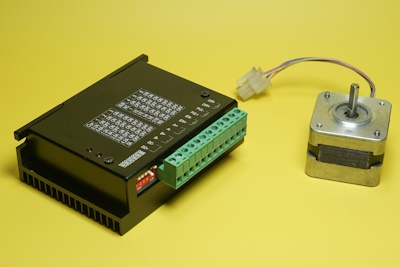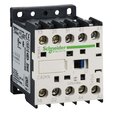IEC vs NEMA Relays - Similarities & Differences

Figure 1: Stepper motor driver module with NEMA 17 motor
Selecting between the IEC or NEMA standards for relays and contactors is crucial for ensuring optimal performance and reliability in industrial automation and control systems. This article explores the key differences between these two classification systems, highlighting their respective advantages and applications. Understanding these distinctions will aid in selecting the most appropriate components for specific operating conditions and system requirements.
Table of contents
- The Background of NEMA and IEC
- What is an IEC product
- What is a NEMA product
- Similarities between IEC and NEMA products
- IEC vs NEMA: Key differences
- Conclusion
The Background of NEMA and IEC
NEMA ratings have historically been the industry standard in North America. These ratings cover electric motors, enclosures, and motor controllers, ensuring that electrical components and enclosures adhere to stringent safety standards. However, IEC standards, initially more specific to Asian and European markets, have become more widely adopted globally, including North America. As globalization continues, electrical designers and engineers increasingly conform to IEC standards.
What is an IEC product
The International Electrotechnical Commission (IEC) is a global organization that develops standards for electrical, electronic, and related technologies. IEC-certified components are compact, economic, and inherently safe for users.
Advantages of IEC-rated devices
- Cost-effective: Generally, IEC devices are designed to be economical, which can be beneficial for large-scale implementations.
- Compact design: IEC devices often have a smaller footprint, making them suitable for applications where space is limited.
- Quick response to overloads: IEC standards emphasize quick response times to overloads, enhancing safety and reliability.
- Inherently safe to touch: IEC standards ensure that devices are designed to be safe for users, minimizing the risk of electrical shock.
What is a NEMA product
The National Electrical Manufacturers Association (NEMA) is the largest trade association for electrical equipment manufacturers in the United States. NEMA standardized frame sizes to ensure parts from different manufacturers are interchangeable and designed components with additional safety factors. NEMA standards cover power generation, distribution, control, transmission, and end-use components, making them versatile and highly suitable for a wide range of applications.
Advantages of NEMA-rated devices
- Excellent short-circuit resistance: NEMA devices are designed to handle high short-circuit currents, making them robust and reliable in demanding environments.
- Versatile and suitable for a wide range of applications: NEMA standards cover a broad spectrum of electrical components, making them adaptable to various applications.
Similarities between IEC and NEMA products
Both NEMA and IEC-rated devices have overlapping benefits and can be designed to meet various requirements, including compactness, safety, and versatility. The choice between the two standards often depends on specific application needs, regional preferences, and industry practices. For example, NEMA relays can be compact (e.g., NEMA size 00 motor starter) and NEMA Type 4X enclosures are designed to be safe to touch.
Here are some key similarities between both standards:
- Safety and performance: Both IEC and NEMA standards aim to ensure that electrical products operate safely and perform reliably under specified conditions.
- Product testing: Products adhering to either IEC or NEMA standards undergo rigorous testing to verify their compliance with safety, performance, and durability requirements.
- Classification systems: Both standards provide classification systems for electrical enclosures, specifying the level of protection against environmental factors such as dust, water, and other contaminants.
- Interchangeability: Many products designed to meet IEC standards can be compatible with those meeting NEMA standards, and vice versa, facilitating easier integration and replacement in various applications. However, specific dimensions and tolerances can vary.
- Quality assurance: Compliance with either set of standards indicates a commitment to quality, as both IEC and NEMA require manufacturers to adhere to stringent quality control processes.
IEC vs NEMA: Key differences
IEC and NEMA standards have several key differences that affect their approaches and applications:
- Different philosophies: NEMA emphasizes robust designs for broader applicability, governed by the NEMA Industrial Control Standard (ICS-2). IEC focuses on performance and application, requiring a sophisticated understanding of duty cycles, motor loads, and full load current functions.
- Features and benefits: NEMA products are known for ease of selection, serviceability, and reserve capacity. They are robust, versatile, and often used in construction jobs. IEC products are designed to be easily customized and put together, making installation quick and straightforward. They are compact and cost-effective, making them ideal for OEM designers. For devices below 100A or 50HP, NEMA-rated motor starters and contactors are larger and more costly. IEC provides more options for specific current or power ratings, making proper selection more critical than for NEMA components.
- Training and market state: One of the biggest differences between IEC and NEMA products is the level of training required. IEC products are more application-specific and require a higher level of knowledge for selection. Over the years, many companies have shifted from NEMA-style contactors and starters to IEC ones, particularly in commercial and light industries. However, process industries have largely remained with NEMA-style devices.
- Service factor: NEMA contactors can have up to a 25% service factor (the ability of the relay or contactor to handle occasional overloads beyond its rated capacity), while IEC focuses on space and cost efficiency by testing components to their exact design rating and using utilization categories to rate devices based on their intended use.
- Construction: NEMA standards address the construction of electrical elements, including corrosion protection, while IEC is more inclined towards IP ratings.
Table 1 provides a comparative analysis of IEC and NEMA standards.
Table 1: IEC vs NEMA standards
| IEC | NEMA |
| Less expensive | More expensive |
| Less versatile; designed for specific applications | More versatile; broad ratings for many applications |
| More compact | Larger |
| Focus on global market | Focus on North American market |
| Faster overload response | Better short-circuit resistance |
| Inherently safe to touch | Requires safety covers |
Conclusion
Both IEC and NEMA classification systems have their strengths. IEC is more compact and cost-effective when operating conditions are well-defined. NEMA devices are preferable when operating conditions, such as load, are not well-defined. IEC relays offer single-phase detection and faster overload response, while NEMA devices handle short circuits more effectively. NEMA relays and contactors require safety covers due to their open design, whereas IEC contactors are inherently safe to touch. IEC devices also provide more options for integrating components into a distributed control system using open Fieldbus standards, which is important in modern plant control systems.





